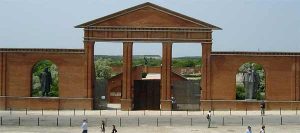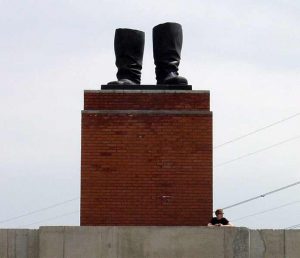Thurs 29/5/08
The Statue Park

Slept like a dead animal, despite (or perhaps, because of) a bed only slightly softer than a park-bench.
Suitably refreshed, and feeling somewhat intrepid, I decide to visit the statue park, full of soviet era monumental sculpture. I’ll start with this, I decided, on the basis that it involves extensive public transport in three flavours. (metro, tram and big yellow volans bus) If I can cope with this, I can cope with anything.
It’s all very easy, really, apart from having to wander around a large building site to find the bus-station (it’s not until the return journey that I notice the large multi-lingual signs helpfully pointing the way, and feel somewhat less intrepid) It takes a while, but is a tribute to Budapest’s excellent public transport system. Why, I wonder, can’t we manage such a thing? The heretical thought that an efficient, properly integrated public transport system might be a positive legacy of communism creeps into my brain. Try as I might, I can’t quite dislodge it.
The Statue Park is one of the strangest places I’ve ever been. At the moment it’s very much a work in progress, and in addition to the statues it will eventually include a cinema/exhibition hall (currently, poignantly, housed in an old wooden barracks), shop and other amenities, all grouped around a memorial square.
As the petrified giant communism had become gradually toppled over, one of the matters for public debate was the fate of all the statues and other soviet paraphernalia (plaques etc) that littered the country, like acne disfiguring a teenage face. The eventual upshot of the debate strikes me as extremely interesting. Rather than destroy it all, or leave it be, it was decided to make a memorial park. Interesting in itself, more intruiging is the location. It’s not anywhere in the city centre, not anywhere that you’d casually happen across; it’s off in the sticks (took me over an hour). It’s fairly well promoted, but you definitely have to want to get here.
Most interesting of all is the stated intention of the architect who won the competition to design the place. To place the statues in ‘quotation marks’, as both a monument to the fact that such a time existed and, by removing them from their original context (simply a means to reinforce ‘the message’) allow them to be viewed as artworks in their own right.

There is some good stuff here- sheer technical prowess at monumental scales and some genuine aesthetic achievement, but the history they memorialise is all still too close for my response to be unclouded by politics, purely aesthetic.
The first thing that strikes the eye seems surreal, almost comical – a truly enormous bronze of a pair of boots. Opposite the entrance, atop a (un-finished) faithful replica of the reviewing platform that once dominated one of the main squares in town. It makes no sense, unless you know the story. At the height of the (brutally repressed, unsuccessful) rebellion on 23rd Oct 1956, chains and ropes were attached to the monumental statue of Stalin that lowered over the square, and it was pulled over – snapped off at the ankles, all that remained was the boots….and an iconic image of freedom, four young men standing around them, waving the Hungarian flag in triumph. Their rebellion failed, the soviet tanks rolled in and a lot of people died.

Now you can buy a post-card of that moment – I did, and felt simultaneously uplifted and somehow ashamed. It’s propped up against a bowl on the table now as I’m typing this up, and my gaze keeps sliding sidelong towards it…as if to remind myself…of what? The heat, the strangeness, the complex mixture of pity and anger the whole place stirred up in me?

The whole thing is arranged quite formally, with brick walls and niches, and is more than a little reminiscent of a cemetery – not an accident, one feels. Harder to know about the profusion of wild flowers all over the place, in the lawns between and behind the exhibits…was this also intentional? I was particularly struck by a cherry tree growing right behind a huge slab of white marble (or concrete?) and then behind that a fair few poppies. Whether intentional or not, the concatenation of this didactic slab of white sculpture, with some worthy emerging from it (very much like a comic-book come to life – very adolescent), the tree and the poppies was strangely moving. A vivid paraphrase of over a century of conflict, betrayal and waste.
Going into the barracks to look at the exhibition (simple series of bi-lingual panels)the first thing you see, can’t avoid seeing, is a huge plaster cast of those same boots. They only just fit under the low wooden ceiling of the hut. The cyclopean scale and extreme whiteness remind me of those remaining fragments of the colossal statue of Constantine that are similarly grotesquely out of scale with their current home (a room in the Vatican, if memory serves…) and perhaps share something of the same original grossly inflated intention to dominate and be worshiped.
The story told by the boards (brief summary of Hungarian history since the end of WWII, with special emphasis on the 1956 uprising) and the explanation of the vision behind the whole park is very interesting, and not a little moving.
I can’t help but contrast the recent ‘re-cycling’ of the Paris riots in 1968 that has claimed a fair amount of media attention here, with the story of the ‘pest kids’ of the 56 uprising. Many of the latter being teenagers, using real guns to fight for what they, and many others across Europe at the time, saw as being the future of freedom.
This is an arresting, vital story, and I’m somewhat ashamed that all I knew of it before coming here was some passing references from a Hungarian friend at college (like many others, his parents got out in 56) …and even then I’d got that confused with that bit from ‘The Unbearable Lightness of Being’…but that was Czechoslovakia, wasn’t it?
This whole place has an un-finished, slightly tentative feel to it which I find very appealing. It draws me in much more readily than would the usual museum or other exhibition, as it lacks the usual air of being the ‘final story’, the approved version.
The Statue Park doesn’t seem like that to me, more like an invitation to think and reflect, to make up my own mind. It’s infinitely more memorable on that account, and I know it’ll stay with me a long time. I really hope completion of the overall plan doesn’t rob this place of this sense of open-ness, of questioning.
